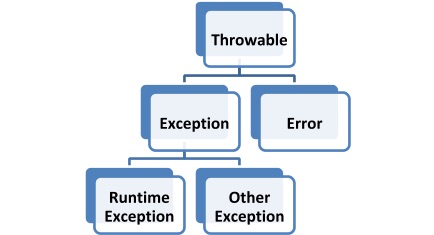更新时间:2022-11-17 12:02:57 来源:赢咖4 浏览694次
Java是一种面向对象的编程语言。它提供对异常处理等各种机制的支持。Java 的这一特性使开发人员能够管理由异常引起的运行时错误。
在本文中,您将了解Java中的异常。您还将了解Java 中不同类型的异常。
Java异常是限制程序正常执行的不需要的错误或错误或事件。每次发生异常时,程序执行都会中断。屏幕上显示一条错误消息。
异常的发生背后有几个原因。这些是发生异常的一些情况:
每当用户提供无效数据时。
请求访问的文件在系统中不存在。
当Java 虚拟机(JVM) 内存不足时。
网络在通信过程中掉线。
现在让我们探索 Java 中不同类型的异常。
所有异常类的父类都是java.lang.Exception类。图 1 说明了不同类型的 Java 异常。


如果我们谈论Exception类,它是内置Throwable类的子类。还有另一个从 Throwable 类派生的子类,即Error,如图 1 所示。错误可以定义为一种异常情况,表明程序的执行出现了问题。这些不是由 Java 程序处理的。
Throwable类中有一些重要的方法可用,如下所示:
public String getMessage() – 提供有关通过消息发生的异常的信息,该消息在Throwable 构造函数中初始化。
public Throwable getCause() – 提供由Throwable 对象表示的异常的根本原因。
public void printStackTrace() – 用于显示toString()的输出以及到System.err(错误输出流)的堆栈跟踪。
public StackTraceElement [] getStackTrace() – 返回一个数组,其中包含堆栈跟踪中存在的每个元素。索引 0 元素将象征调用堆栈的顶部,数组的最后一个元素将标识调用堆栈的底部。
Java中主要有以下两种类型的异常:
检查异常
未经检查的异常
检查异常也称为编译时异常,因为这些异常在编译过程中由编译器检查,以确认程序员是否处理了异常。如果不是,则系统显示编译错误。例如,SQLException、IOException、InvocationTargetException和ClassNotFoundException。
为了说明检查异常的概念,让我们考虑以下代码片段:
import java.io.*;
class demo1 {
public static void main(String args[]) {
FileInputStream input1 = null;
/* FileInputStream(File filename) is a constructor that will throw
* FileNotFoundException (a checked exception)
*/
input1 = new FileInputStream("D:/file.txt");
int m;
// The read() of FileInputStream will also throw a checked exception
while(( m = input1.read() ) != -1) {
System.out.print((char)m);
}
// The close() will close the file input stream, and it will also throw a exception
input1.close();
}
}
输出
Exception in thread "main" java.lang.Error: Unresolved compilation problems:
Unhandled exception type FileNotFoundException
Unhandled exception type IOException
Unhandled exception type IOException
输出中清楚地显示程序在编译过程中抛出异常。有两种方法可以解决此类问题。您可以在throw关键字的帮助下声明异常。
import java.io.*;
class demo1 {
public static void main(String args[]) throws IOException {
FileInputStream input1 = null;
input1 = new FileInputStream("D:/file.txt");
int m;
while ((m = input1.read()) != -1) {
System.out.print((char)m);
}
input1.close();
}
}
输出:文件将显示在屏幕上。
除了上述方法外,还有一种解决异常的方法。您可以在try-catch 块的帮助下管理它们。
import java.io.*;
class demo1 {
public static void main(String args[]) {
FileInputStream input1 = null;
try {
input1 = new FileInputStream("D:/file.txt");
} catch(FileNotFoundException input2) {
system.out.println("The file does not " + "exist at the location");
}
int m;
try {
while((m = input1.read()) != -1) {
System.out.print((char)m);
}
input1.close();
} catch(IOException input3) {
system.out.println("I/O error occurred: "+ input3);
}
}
}
输出:代码将顺利运行并显示文件。
现在,让我们了解其他检查异常。他们之中有一些是:
此类异常发生在对与 SQL 语法相关的数据库执行查询时。例如,考虑以下代码片段:
public void setClientInfo ( String sname , String svalue ) throws SQLClientInfoException { try {
checkClosed (); ((java.sql.Connection)这个.mc)。_ _ _ setClientInfo (名称,值); } catch ( SQLException sqlEx ) { try {
checkAndFireConnectionError ( sqlEx );
} catch ( SQLException sqlEx2 ) { SQLClientInfoException client_Ex = new SQLClientInfoException ();
client_Ex 。初始化原因(sqlEx2 );抛出client_Ex ;} } }
输出:此代码将生成 SQLException。
这种类型的异常发生在使用文件 I/O 流操作时。例如,考虑以下代码片段:
import java.io.*;
public class sample_IOException {
private static String filepath = "D:\User\guest\Desktop\File2.txt";
public static void main(String[] args) {
BufferedReader br1 = null;
String curline;
try {
br1 = new BufferedReader(new FileReader(filepath));
while ((curline = br1.readLine()) != null) {
System.out.println(curline);
}
} catch (IOException e) {
System.err.println("IOException found :" + e.getMessage());
} finally {
try {
if (br1 != null)
br1.close();
} catch (IOException e) {
e.printStackTrace();
}
}
}
}
输出:此代码将生成 IOException。
当 JVM 无法找到所需的类时,将抛出此类异常。这可能是由于命令行错误、类路径问题或缺少 .class 文件造成的。例如,考虑以下代码片段:
public class sample_ClassNotFoundException {
private static final String CLASS_TO_LOAD = "main.java.Utils";
public static void main(String[] args) {
try {
Class loadedClass = Class.forName(CLASS_TO_LOAD);
System.out.println("Class " + loadedClass + " found!");
} catch (ClassNotFoundException ex) {
System.err.println("ClassNotFoundException was found: " + ex.getMessage());
ex.printStackTrace();
}
}
}
输出:此代码将生成 ClassNotFoundException。
这种类型的异常包装由调用的方法或构造函数抛出的异常。可以借助getTargetException方法访问抛出的异常。例如,考虑以下代码片段:
package main.samplejava;
import java.lang.reflect.InvocationTargetException;
import java.lang.reflect.Method;
public class Example {
@SuppressWarnings("unused")
private int test_sample(String s1) {
if (s1.length() == 0)
throw new IllegalArgumentException("The string should have at least one character!");
System.out.println("Inside test_sample: argument's value equals to: "" + s1 + """);
return 0;
}
public static void main(String... args) {
try {
Class<?> c1 = Class.forName("main.samplejava. Example");
Object t1 = c1.newInstance();
Method[] declared_Methods = c1.getDeclaredMethods();
for (Method method : declared_Methods) {
String methodName = method.getName();
if (methodName.contains("main"))
continue;
System.out.format("Invoking %s()%n", methodName);
try {
method.setAccessible(true);
Object returnValue = method.invoke(t1, "");
System.out.format("%s() returned: %d%n", methodName, returnValue);
} catch (InvocationTargetException ex) {
System.err.println("An InvocationTargetException was caught!");
Throwable cause = ex.getCause();
System.out.format("Invocation of %s failed because of: %s%n",
methodName, cause.getMessage());
}
}
} catch (ClassNotFoundException | InstantiationException | IllegalAccessException ex) {
System.err.println("The following exception was thrown:");
ex.printStackTrace();
}
}
}
输出
Invoking testMethod()
An InvocationTargetException was caught!
Invocation of testMethod failed because of: The string must contain at least one character!
输出:此代码将生成 InstantiationException。
未经检查的异常是在程序执行期间发生的那些异常。因此它们也被称为运行时异常。这些异常在编译过程中一般会被忽略。编译程序时不检查它们。例如,逻辑错误和使用不正确的 API 等编程错误。
为了说明未经检查的异常的概念,让我们考虑以下代码片段:
import java.util.Scanner;
public class Sample_RunTimeException {
public static void main(String[] args) {
// Reading user input
Scanner input_dev = new Scanner(System.in);
System.out.print("Enter your age in Numbers: ");
int age1 = input_dev.nextInt();
if (age1>20) {
System.out.println("You can view the page");
} else {
System.out.println("You cannot view the page");
}
}
}
输出1
Enter your age in Numbers: 21
You can view the page
输出2
Enter your age in Numbers: Twelve
Exception in thread “main” java.util.InputMismatchException
at java.util.Scanner.throwFor (Unknown Source)
at java.util.Scanner.next (Unknown Source)
at java.util.Scanner.nextInt (Unknown Source)
at java.util.Scanner.nextInt (Unknown Source)
at exceptiondemo.sample_runtimedemo.main(Sample_RunTimeExceptionDemo.java:11)
现在,让我们了解其他未检查的异常。他们之中有一些是:
当您尝试借助当前值为 null 或空的引用变量访问对象时,会发生此类异常。例如,考虑以下代码片段:
// Program to demonstrate the NullPointerException
class SampleNullPointer {
public static void main(String args[]) {
try {
String a1 = null; // null value
System.out.println(a1.charAt(0));
} catch(NullPointerException e) {
System.out.println("NullPointerException is found in the program.");
}
}
}
输出:在程序中发现 NullPointerException。
当您尝试访问具有无效索引值的数组时,会发生此类异常。您提供的值是负数或超出数组的长度。
例如,考虑以下代码片段:
// Program to demonstrate the ArrayIndexOutOfBoundException
class sample_ArrayIndexOutOfBound {
public static void main(String args[]) {
try {
int b[] = new int[6];
b[8] = 2; // we are trying to access 9th element in an array of size 7
} catch(ArrayIndexOutOfBoundsException e) {
System.out.println ("The array index is out of bound");
}
}
}
输出:数组索引越界
每当将不适当或不正确的参数传递给方法时,就会发生这种类型的异常。例如,如果一个方法是用非空字符串作为参数定义的。但是您提供的是空输入字符串。然后,抛出 IllegalArgumentException以指示用户您不能将空输入字符串传递给该方法。
请考虑以下代码片段来演示此类异常:
import java.io.File;
public class Sample_IllegalArgumentException {
public static String createRelativePath(String par, String f_name) {
if (par == null)
throw new IllegalArgumentException("You cannot provide null parent path!");
if (f_name == null)
throw new IllegalArgumentException("Please enter the complete filename!");
return par + File.separator + f_name;
}
public static void main(String[] args) {
// This command will be successfully executed.
system.out.println(IllegalArgumentExceptionExample.createRelativePath("dir1", "file1"));
system.out.println();
// This command will throw an IllegalArgumentException.
System.out.println(IllegalArgumentExceptionExample.createRelativePath(null, "file1"));
}
}
Output: This code will generate an IllegalArgumentException.
当环境状态与正在执行的操作不匹配时,就会发生这种类型的异常。例如,考虑下面的代码片段,它演示了这种类型的异常:
/**
* This code will publish the current book.
* If the book is already published, it will throw an IllegalStateException.
**/
public void pub() throws IllegalStateException {
Date pub_at = getPub_at();
if (pub_at == null) {
setPub_at(new Date());
Logging.log(String.format("Published '%s' by %s.", getTitle(), getAuthor()));
} else {
throw new IllegalStateException(
String.format("Cannot publish '%s' by %s (already published on %s).",
getTitle(), getAuthor(), pub_at));
}
}
输出:此代码将生成 IllegalStateException。
如果系统中已经存在出版日期,那么它将产生一个 IllegalStateException 指示该书不能再次出版。
当您将字符串传递给无法转换为数字的方法时,会发生此类异常。例如,考虑以下代码片段:
// Program to demonstrate the NumberFormatException
class Sample_NumberFormat {
public static void main(String args[]) {
try {
// "Test" is not a number
int n = Integer.parseInt ("Test") ;
System.out.println(n);
} catch(NumberFormatException e) {
System.out.println("Number format exception");
}
}
}
输出:此代码将生成 NumberFormatException。
当您执行不正确的算术运算时,会发生这种类型的异常。比如任意一个数除以零,就会显示这样的异常。让我们考虑以下代码片段:
// Program to demonstrate the ArithmeticException
class Sample_ArithmeticException {
public static void main(String args[]) {
try {
int p = 30, q = 0;
int r = p/q; // It cannot be divided by zero
System.out.println ("Result = " + r);
} catch(ArithmeticException e) {
System.out.println ("Number cannot be divided by 0");
}
}
}
输出:此代码将生成一个 ArithmeticException。
以上就是关于“Java异常类型汇总”的介绍,大家如果想了解更多相关知识,不妨来关注一下本站的Java基础教程,里面的课程内容细致全面,很适合没有基础的小伙伴学习,希望对大家能够有所帮助哦。
 Java实验班
Java实验班
0基础 0学费 15天面授
 Java就业班
Java就业班
有基础 直达就业
 Java夜校直播班
Java夜校直播班
业余时间 高薪转行
 Java在职加薪班
Java在职加薪班
工作1~3年,加薪神器
 Java架构师班
Java架构师班
工作3~5年,晋升架构
提交申请后,顾问老师会电话与您沟通安排学习